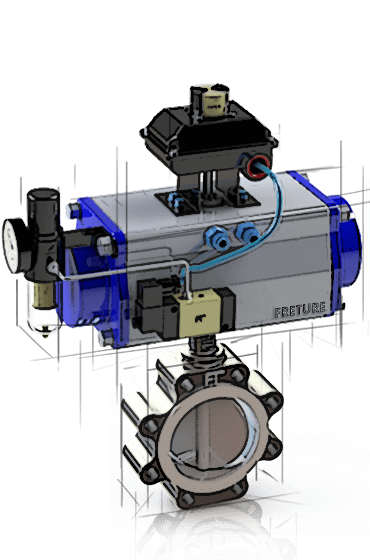Engineering Excellence for Corrosive and Demanding Environments
In industrial applications where chemical resistance and sealing integrity determine process reliability, PTFE Butterfly Valves have become a trusted choice. Their ability to handle aggressive fluids, corrosive gases, and high-purity liquids makes them indispensable in chemical, pharmaceutical, and food processing plants. The combination of precision design and PTFE (Polytetrafluoroethylene) lining offers unmatched performance even in the harshest conditions.
Unlike traditional metal-seated butterfly valves, PTFE-lined variants provide a perfect seal and long-term durability without the risk of contamination or leakage. Every element of their construction — from the disc to the stem — is engineered to ensure reliability under continuous operation.
Material Advantage: Why PTFE Lining Matters
PTFE, known for its exceptional chemical inertness, provides superior resistance against acids, alkalis, and solvents. When used as a lining in butterfly valves, it prevents the internal metal parts from coming into contact with corrosive media. This significantly extends the valve’s service life while minimizing maintenance needs.
The non-stick surface of PTFE also helps avoid material buildup, a common problem in process lines handling viscous or sticky media. It ensures a consistent flow rate, reduces pressure drop, and maintains efficiency throughout the valve’s operational cycle.
Additionally, PTFE’s broad temperature tolerance — typically ranging from -30°C to +180°C — allows these valves to be deployed in diverse process conditions without performance degradation.
Precision Design for Optimal Flow Control
The PTFE Butterfly Valve is designed for precision. Its disc operates with minimal friction, allowing smooth rotation and accurate throttling control. The valve’s geometry ensures a tight shutoff even under differential pressures, eliminating internal leaks.
The stem design incorporates a blow-out-proof feature, ensuring operational safety under pressure. Advanced seat designs with resilient backing materials enhance sealing performance, while maintaining the flexibility required for repetitive operations.
Whether the valve is operated manually or through an actuator, it delivers consistent torque performance and smooth modulation. This makes PTFE-lined butterfly valves ideal for automated process systems that demand accuracy and repeatability.
Performance in Corrosive Applications
Industries handling aggressive chemicals or ultra-pure fluids depend heavily on material compatibility. Traditional metallic valves often corrode or leach contaminants into the product stream, compromising both safety and quality. PTFE Butterfly Valves eliminate these risks.
In chemical processing plants, these valves resist attack from strong acids such as hydrochloric, nitric, and sulfuric acid. In pharmaceutical and biotech facilities, PTFE’s non-reactive nature ensures purity in water and process lines. Food and beverage industries also rely on PTFE valves for their hygienic, easy-to-clean surfaces that prevent bacterial growth and product contamination.
This corrosion-resistant nature not only reduces unplanned downtime but also supports compliance with stringent industry standards, such as FDA and USP Class VI, where applicable.
Operational Benefits and Maintenance Efficiency
One of the biggest advantages of using PTFE Butterfly Valves is reduced maintenance. Since the lining protects against corrosion and erosion, the valve retains its performance characteristics over extended use. This minimizes the frequency of replacements and inspections — saving both time and cost.
Their lightweight construction compared to other valve types allows easier installation and reduced stress on pipelines. The simple quarter-turn operation further simplifies automation, making them compatible with electric, pneumatic, or hydraulic actuators.
From an operational standpoint, the combination of leak-free performance, chemical resistance, and low torque requirement enhances process efficiency. These attributes make PTFE Butterfly Valves a long-term, cost-effective investment for modern industrial facilities.
Sustainability and Reliability in Design
In today’s process industries, environmental considerations are as critical as performance. PTFE-lined valves prevent fluid emissions and leakage, contributing to safer and more sustainable operations. Their long service life reduces material waste and replacement frequency, aligning with green manufacturing initiatives.
Moreover, the valve’s reliability under cyclic operation ensures stable performance even in systems subjected to frequent open-close actions — a common scenario in automated control processes.
Conclusion
PTFE Butterfly Valves combine the strength of engineering precision with the reliability of advanced materials. They provide the perfect balance between corrosion resistance, flow efficiency, and operational economy. For industries dealing with corrosive, high-purity, or temperature-sensitive fluids, these valves deliver unmatched dependability.
If you’re looking for high-quality PTFE Butterfly Valves designed to perform in critical industrial conditions, Freture Techno Pvt. Ltd. stands as a leading PTFE Butterfly Valve manufacturer in India. With a commitment to quality, innovation, and customer satisfaction, Freture Techno ensures that every valve delivers reliability that drives industrial progress.


